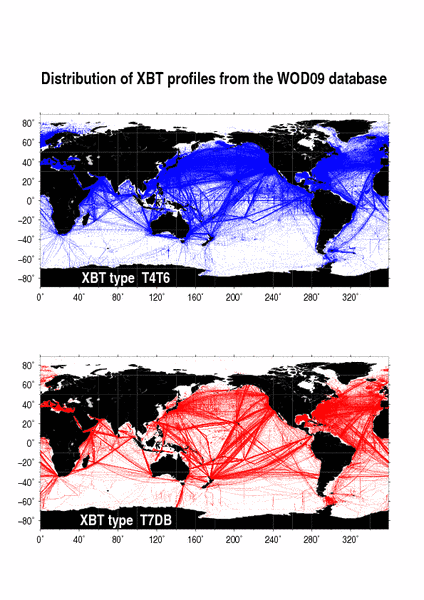XBT correction and Interpolation

Expendable bathythermograph (XBT) measures temperature down to the depth of about 800 m from a moving ship. Since the late 1960s XBTs contributed the majority of the subsurface temperature measurements in the ocean. However the XBT sample depth is not measured but calculated from the estimated fall-rate. The uncertainties in the fall-rate and the malfunctioning of the acquisition system cause XBT temperatures to be biased.
Biases in the XBT data has been documented in the literature since 1970s, but it was not until recently that their integrated effect on the global heat content calculations has been estimated. The XBT temperature bias was shown to be comparable in magnitude with the typical decadal-scale temperature variability , so that neglecting this bias can seriously distort our estimates of global ocean climate change. Using original XBT data from the World ocean database WOD09 (Boyer et al., 2009) we provide a data product which includes depth- and temperature-corrected XBT profiles. The correction method is based on the recent study by Gouretski and Reseghetti (2010).
More information about this data set
XBT Bias and Fall-Rate Workshop, Hamburg, Germany, 25-27 August 2010
The Cluster of Excellence "Integrated Climate System Analysis and Prediction" (CLISAP) of the University of Hamburg, Germany, was hosting the second XBT Bias and Fall-rate Workshop during 25-27 August 2010. Similar to the first workshop held in Miami in March 2008 the second workshop was dedicated both to the analysis of the XBT data and errors. We have discussed the recent findings related to the XBT data since March 2008 in order to develop new correction schemes both for the existing global XBT dataset and for the future observational programs.
Here are the presentations as pdf for download:
- Boyer, (pdf, not barrier-free)
- Cheng, (pdf, not barrier-free)
- Cowley, (pdf, not barrier-free)
- Di Nezio, (pdf, not barrier-free)
- Goni, (pdf, not barrier-free)
- Gopalakrishna, (pdf, not barrier-free)
- Gouretski, (pdf, not barrier-free)
- Hamon and Guinehut, (pdf, not barrier-free)
- Hanawa, (pdf, not barrier-free)
- Ishii, (pdf, not barrier-free)
- Johnson, (pdf, not barrier-free)
- Kizu, (pdf, not barrier-free)
- Klein, (pdf, not barrier-free)
- Lyman, (pdf, not barrier-free)
- Morris, (pdf, not barrier-free)
- Pezzoli, (pdf, not barrier-free)
- Reseghetti, (pdf, not barrier-free)
- Stammer, (pdf, not barrier-free)
- Tresher, (pdf, not barrier-free)
- Trinanes, (pdf, not barrier-free)
- Van Caspel,(pdf, not barrier-free)
- Willis,(pdf, not barrier-free)
Here is the Final report of the XBT Workshop (pdf, not barrier-free).
References
T. P. Boyer, J. I. Antonov, O. K. Baranova, H. E. Garcia, D. R. Johnson, R. A. Locarnini, A. V. Mishonov, T. D. O’Brien, D. Seidov, I. V. Smolyar, M. M. Zweng, 2009: World Ocean Database 2009, Chapter 1: Introduction, NOAA Atlas NESDIS 66, Ed. S. Levitus, U.S. Gov. Printing Office, Wash., D.C., 216 pp., DVD. (pdf, not barrier-free
